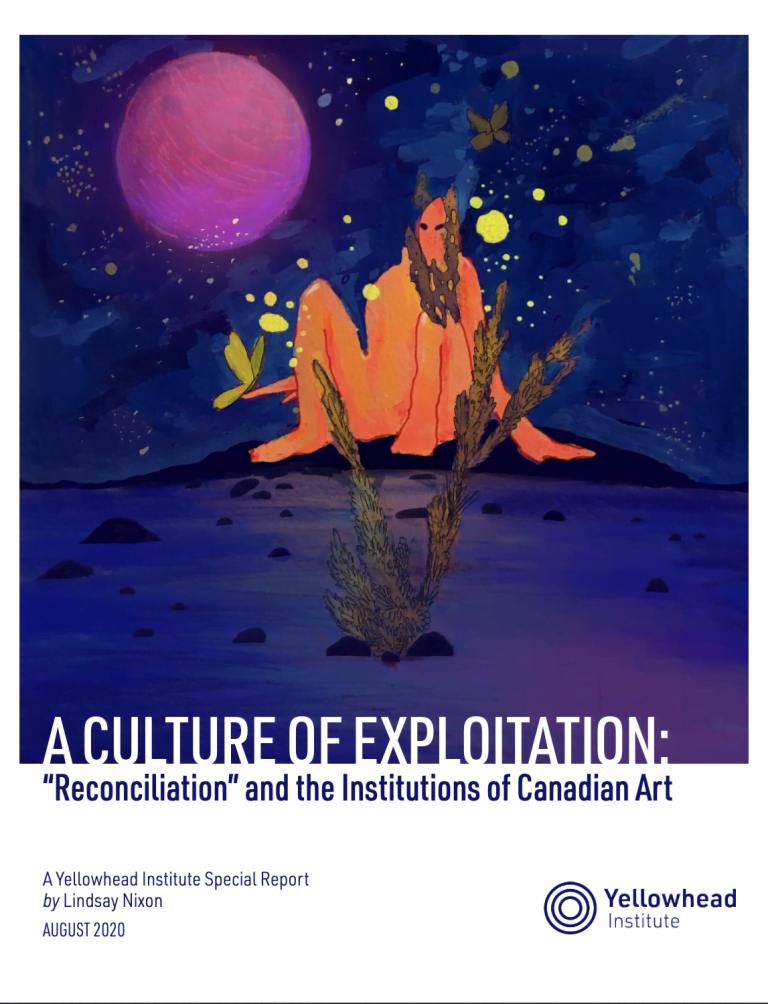10 search results
for
Public sector
Recommendation 2:
No more Indigenous advisory committees. Integrate diverse Indigenous peoples and knowledges throughout corporate structures, on both the creative and business side of organizations, and not just in moments of increased fiscal attachment to monetized identity politics.
-
Category and theme:
Audience:
Groups affected:
Location of recommendation:
Recommendation 3:
Put the onus of learning on the actors within cultural institutions. Avoid tasking the decolonizing of an entire organization on one employee especially within Canada’s long running heritage institutions, museums, publications, and galleries, which will have deeply entrenched cultures of white supremacy.
- Avoid the single Indigenous hire into segregated positions. Only diverse, block hires of Black and Indigenous peoples moving forward, coinciding with the realization that this might mean the radical restructuring of institutions (such as retirements and staff changes), and the implementations of Indigenous and Black peoples throughout organizations in self-determined ways.
- Respect the interests of diverse Black and Indigenous peoples, and their varying desires to participate in diversity and decolonizing measures (i.e. Indigenous specific departments and programs, or self-determined integration into wider institutional spaces away from a focus on Indigenous issues).
-
Category and theme:
Audience:
Groups affected:
Location of recommendation:
Recommendation 4:
Always centre care, capacity, realistic timeframes, and meaningful responses when addressing the concerns of Indigenous employees, and only request those perspectives with the expressed consent of employees.
- Make culturally sensitive supports available to employees. Take every claim of harm seriously, and centre genuine concern towards healing and mediating those facets of the institutional culture. Never gaslight employees.
- Always consult from within as opposed to without the organization, putting less focus on tokenistic measures such as business consultants and more focus on the integration of anti-racist structures and cultures, and Black and Indigenous decolonial ideologies and peoples throughout workplaces.
-
Category and theme:
Audience:
Groups affected:
Location of recommendation:
Recommendation 5:
Ensure the growth of Black and Indigenous cultural workers into senior positions. Ensure Black and Indigenous staff are given the opportunity to interview for senior positions and foster a practice of hiring from within. Where possible and appropriate provide mentorship to those employees and include explicitly in succession planning.
-
Category and theme:
Audience:
Groups affected:
Location of recommendation:
Recommendation 6:
Recognize that competition is endemic within art industries and ensure that policies and structures are implemented that ensure management, senior curators, senior editors, and other high-level positions are held accountable for gatekeeping, racist and misogynist micro-aggressions, preferential treatment of white employees and men, and workplace bullying, gossip, and other toxic cultures of white supremacy and misogyny in the ways they work, and the cultures they thereby promote within their organizations.
-
Category and theme:
Audience:
Groups affected:
Location of recommendation:
Recommendation 13:
Indigenous publications, organizations, galleries, and other cultural institutions should immediately recruit Indigenous editors and department heads, if these positions are still held by non-Indigenous peoples. This might mean investing in mentorship processes and understanding that Indigenous qualifications can look different than non-Indigenous qualifications. This may require re-considering the concept of “quality”, production schedules, and other tools for organizational structure and workplace culture.
-
Category and theme:
Audience:
Groups affected:
Location of recommendation:
Recommendation 14:
Restitution should be embedded in fee structures. Indigenous artists should receive higher resale fees, especially communities that have been historically exploited by the market (such as Inuit). Regardless of industry standards, Black and Indigenous artists should receive fees for showing in private and commercial galleries.
-
Category and theme:
Audience:
Groups affected:
Location of recommendation:
Recommendation 15:
There should be a drive for greater gender and racial equity in gallery exhibitions. For instance, a guiding principle might mandate that Black women artists booking a solo exhibition be paid the same rate as the highest paid white man artist. In fact, institutions should recognize that certain communities deserve to be paid more for their time and adopt an equity payscale. This can be considered another form of restitution for historic and ongoing marginalization of Indigenous and Black individuals and communities, which requires more labour to participate in the industry compared to non-Indigenous, white peers.
-
Category and theme:
Audience:
Groups affected:
Location of recommendation:
Recommendation 16:
For the foreseeable future, the acquisitions budget of Canadian art institutions must be solely dedicated to the acquisition of Black and Indigenous art. This acquisition campaign must not be merely history art about Indigenous and Black peoples; even if this means collecting primarily contemporary artists.
-
Category and theme:
Audience:
Groups affected:
Location of recommendation:
Recommendation 18:
Cultural organizations should respect the basic human rights and occupational health of Indigenous and Black artists during COVID-19. Arts organizations may consider shifting to a service provision model at this time. But also accepting that artists may not be able to travel in the upcoming months (years even). Organizations should find alternative ways to feature and service the artists they represent.
-
Category and theme:
Audience:
Groups affected:
Location of recommendation:
